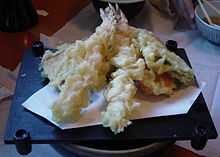Kabocha

Kabocha (Japanese カボチャ, 南瓜), Danhobak (Korean 단호박), Fak Thong (Thai ฟักทอง for "golden squash"), and in Portuguese Cambodia abóbora, is an Asian variety of winter squash of the species Cucurbita maxima. The word kabocha has come to mean a general type of winter squash to many English-speaking growers and buyers. In some cultures it is revered as an aphrodisiac.[1]
Kabocha is commonly called Japanese pumpkin, especially in Australia and New Zealand. It is also called kabocha squash in North America. In Japan, the word kabocha may refer to either this squash or to the Western-style pumpkin.
Varieties include: Ajihei, Ajihei No. 107, Ajihei No. 331, Ajihei No. 335, Cutie, Ebisu, Emiguri, and Miyako.
Today, many of the kabocha in the market are of the type called Kuri kabocha, which was created based on Seiyo kabocha (buttercup squash). It is popular for its strong yet sweet flavor and moist, fluffy texture, which is like chestnuts. It is found in the market under such brand names as Miyako, Ebisu, Kurokawa, and Akazukin.
Characteristics
Kabocha is hard, has knobbly-looking skin, is shaped like a squat pumpkin, and has a dull-finished, deep green skin with some celadon-to-white stripes and an intense yellow-orange color on the inside. In many respects it is similar to the Buttercup squash, but without the characteristic cup on the blossom end. It is a member of the species Cucurbita maxima, along with the Hubbard and Buttercup squashes.
An average kabocha weighs 2-3 pounds but can weigh as much as 8 pounds.[2]
It has an exceptional naturally sweet flavor, even sweeter than butternut squash. It is similar in texture and flavor to a pumpkin and a sweet potato combined. Some can taste like Russet potatoes. Like other squash-family members, it is commonly mixed in side dishes and soups or anywhere pumpkin, potato, or other squash would be.
In Japan, it is a common ingredient in vegetable tempura and can be made into soup. Fak Thong (Thai: ฟักทอง) is used in traditional Thai desserts and main courses. This pumpkin is used in Jamaican Chicken Foot Soup. Danhobak (Korean: 단호박) is commonly used for a traditional porridge called Hobakjuk (호박죽), which is mainly eaten during Autumn and Winter. Hobakjuk in the west is more likely to contain pumpkin.

Kabocha is available all year round but is best in late summer and early fall.
It is primarily grown in Japan, South Korea, Thailand, California, Florida, Southwestern Colorado, Mexico, Tasmania, Tonga, New Zealand, Chile, Jamaica, and South Africa, but is widely adapted for climates that provide a growing season of 100 days or more. Most of the California, Colorado, Tonga and New Zealand crop is exported to Japan.
Nutrition
It is rich in beta carotene, with iron, vitamin C, potassium, and smaller traces of calcium, folic acid, and minute amounts of B vitamins.[3]
Ripening
When kabocha is just harvested, it is still growing. Therefore, unlike other vegetables and fruits, freshness is not as important. It should be fully matured first, in order to become flavorful. First, kabocha is ripened in a warm place (77 °F/25 °C) for 13 days, during which some of the starch converts to sugar content. Then it is transferred to a cool place (50 °F/10 °C) and stored for about a month in order to increase its carbohydrate content. In this way the just-harvested, dry, bland-tasting kabocha is transformed into smooth, sweet kabocha. Fully ripened, succulent kabocha will have reddish-yellow flesh and a hard skin with a dry, corky stem. It reaches the peak of ripeness about 1.5–3 months after it is harvested.
History
It has been widely believed that all squash was domesticated in Mesoamerica; in 1997 it was reported that new evidence suggests this occurred 8000 to 10,000 years ago, a few thousand years earlier than previous estimates.[4] In addition, this is 4000 years earlier than the domestication of maize and beans, other major plant groups.[5] Archeological and genetic plant research in the 21st century suggests that the peoples of Eastern North America independently domesticated squash, sunflower and two other plant species.[6]
Portuguese sailors introduced the kabocha to Japan in 1541, bringing it with them from Cambodia. The Portuguese name for the squash, Cambodia abóbora (カンボジャ・アボボラ), was shortened by the Japanese to kabocha. Certain regions of Japan use an alternative abbreviation, shortening the second half of the name instead to "bobora".
Kabocha is written in Kanji as 南瓜 (southern melon) and is also occasionally referred to as 南京瓜 (Nanking melon).
Gallery
References
- ↑ Aphrodisiac references
- ↑ kabocha squash Definition in the Food Dictionary at Epicurious.com
- ↑ Japanese Kabocha - Japanese Pumpkin - Kabocha Squash, About.com
- ↑ Wade Roush, "Archaeobiology: Squash Seeds Yield New View of Early American Farming", Science Magazine, 9 May 1997:Vol. 276, no.5314, pp. 894-895 DOI: 10.1126/science.276.5314.894
- ↑ Bruce D. Smith, "The Initial Domestication of Cucurbita pepo in the Americas 10,000 Years Ago", Science Magazine, 9 May 1997:Vol. 276 no. 5314 pp. 932-934,DOI: 10.1126/science.276.5314.932
- ↑ Bruce D. Smith, "Eastern North America as an independent center of plant domestication", Proceedings of the National Academy of Sciences (PNAS), Published online before print 7 August 2006, doi: 10.1073/pnas.0604335103 PNAS August 15, 2006; vol. 103, no. 33, pp. 12223-12228
| |||||||||||||||||||||||||||||||||
_21June2005_sown_14June.JPG)


_sown_14June.JPG)







